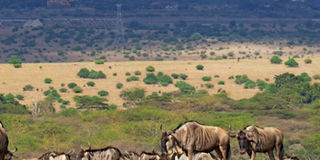Where man and animal live together

Wildebeest in Naretunoi Conservancy. PHOTO | RUPI MANGAT
What you need to know:
- Twenty-one Maasai households have leased 1,700 acres of their land to TWF in exchange for allowing the wildlife to wander through, with more households on the waiting list.
- TWF set up the conservancy as a way to generate funds for the many projects under its umbrella that includes The Wildlife Foundation Centre.
- The wild animals use the park as a refuge in the dry season but when the rains arrive, they scatter on the plains all the way up to Isinya and beyond to Amboseli.
“We have everything here,” says Moses Parmisa of The Wildlife Foundation. “If you had spent the night here you would have heard the lions and the hyenas.”
We’re chatting over a cup of tea and cakes at the foundation centre, on a lawn dotted with wooden sculptures collected from around Africa. On arrival we were met by Impi, a two-year-old female antelope whose mother was killed by a predator. The foal now thinks she’s a ‘people’. “Impi wouldn’t survive out there,” says Jacob Tunoi of TWF. She follows him around like a puppy.
‘Out there’ is Nairobi National Park (NNP) that’s unfenced on the southern side. The boundary is the Mbagathi River. On this side, Naretunoi Conservancy was founded in 2016. ‘Naretunoi’ means ‘to support each other’, which includes coexisting with wildlife. Twenty-one Maasai households have leased 1,700 acres of their land to TWF in exchange for allowing the wildlife to wander through, with more households on the waiting list.
TWF set up the conservancy as a way to generate funds for the many projects under its umbrella that includes The Wildlife Foundation Centre, employing wildlife scouts, monthly wildlife censuses and building predator-proof bomas with lion-lights installed to fool the lions into thinking that people are wandering around.
We’re walking over the dry riverbed called Emakoko to end up at the foot of a hill on the banks of the Mbagathi River. It’s the boundary between the conservancy and NNP. The wild animals use the park as a refuge in the dry season but when the rains arrive, they scatter on the plains all the way up to Isinya and beyond to Amboseli. It’s in Isinya that the wildebeest calf between March and June.
EXCITED
Driving in through Kitengela from Nairobi, the scenery feels reminiscent of the Mara. Turns out a parallel migration of the wildebeest used to take place here, across the Athi-Kitengela plains to Nairobi National Park. It ended in the 1990s when the Namanga road was built and buildings like the cement factories and fences came up.
We’re standing at the banks of the river that’s lined by tall yellow fever acacias and massive fig trees when Parmisa announces, “The rhinos come out here almost every day.” At first we think the Maasai man is joking.
“We have two sets of rhinos,” he continues. “If you are here by 6.30am, you won’t miss them.” It’s the critically endangered black rhino.
“Some of the black rhinos that were taken to Tsavo and died this year were the ones that came here,” says Parmisa. As we talk, I notice the imprint of saucer-shaped giraffe footprints from the giraffes which strolled around on the plains earlier in the morning.
The walk is getting more exciting and I’m cursing myself for not spending the night here because dawn and dusk are the two best times to see the rhino and the cats. “We had an old leopard who died here in July,” continues Parmisa. They installed camera traps by its carcass and watched how the hyenas came and ate her clean during the night.
“There are more lions in the park today,” Solonka says. “In 2013 there were nine lions. In 2018, there are 40.”
Nairobi National Park is the core of the wildlife-rich plains. Without it the plains would lose the wildlife and in tandem, the plains would become bare. Both need each other to survive.
www.rupitheafricantrotter.wordpress.com




